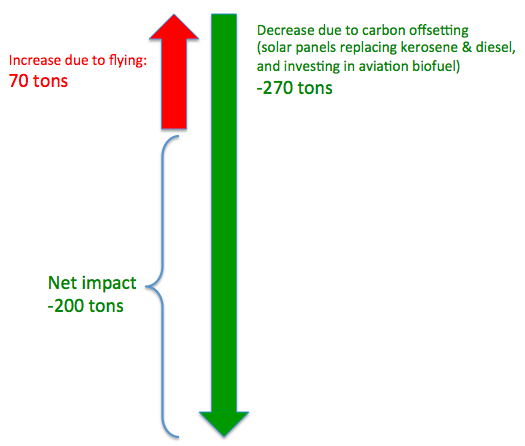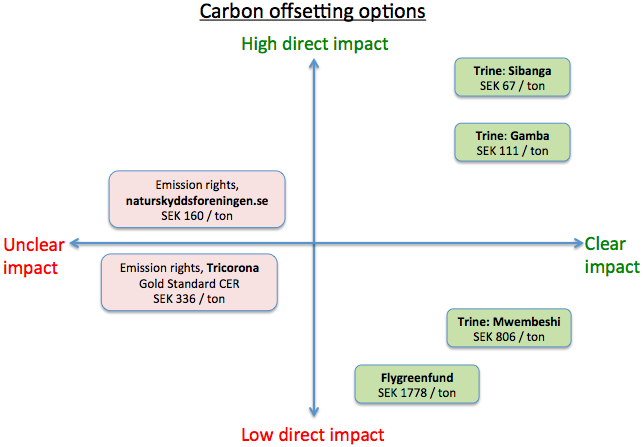Flying causes global warming. That sucks. But neverthless, we fly sometimes. Conferences, vacations, business trips. So what can we do? Well, here’s a simple rule of thumb:
- Fly as little as possible. Reduce the frequency & distance. Consider train for shorter trips.
- When you do fly, make sure you carbon offset. From wikipedia: “A carbon offset is a reduction in emissions of carbon dioxide or greenhouse gases made in order to compensate for or to offset an emission made elsewhere.”
The obvious question then is – HOW do you carbon offset? I was surprised when I dug into it. “Traditional” carbon offsetting (buying emission credits and things like that) seems pretty useless! I couldn’t find any credible evidence that it makes a real difference! Almost like a scam.
So is there another way to carbon offset? Yes! This chart summarizes some of what I’ve learned so far. Read on for details. Got any more suggestions? Add comments. But please quantify.
UPDATE (Jan 2018): We’ve created a service to provide effective carbon offsetting. Check out GoClimateNeutral.org
(see this spreadsheet for the underlying numbers)
At Crisp we recently made a policy decision, unanimously:
- For every flight organized by Crisp, we set aside SEK 100 per passenger-flight-hour to a carbon offset account.
- That carbon offset account is managed by Climate Crisplet – a subset of people in Crisp who are interested in this kind of stuff and make sure the money is spent wisely. We try to maximize ROI in terms of CO2-reduction per money invested.
Why 100kr? Because flying emits about 0.23 tons of CO2eq per passenger hour <ref1, ref2, ref3>. It varies a bit depending on length of flight, speed, height, aircraft model, etc. But 0.23 tons per passenger-hour is a pretty reliable average (including radiative forcing).
CO2eq (Carbon dioxide equivalent) is the official unit of measurement for greenhouse gases. It is a way of aggregating different types of gases (such as CO2, methane, and others) into a single unit. We emit about 50 billion tons of CO2eq per year worldwide, and that’s the key driver of climate change.
So a 4-hour flight results in about 1 ton of greenhouse gas per passenger. We can’t take that specific ton back, it will stay in the atmosphere for many decades. But can we somehow pay to stop a DIFFERENT 1 ton of greenhouse gases from being emitted somewhere else? If so we’re fine right?
I’ve dug deep into this and concluded that yes, we can! And 400kr, if wisely spent, should be more than enough. Hence, 100kr per passenger-hour. We just need to be picky about HOW we spend it.
Our last conference trip involved flying 35 people to Marbella and back (9 hours of flying, there and back). So 315 passenger-hours, or 71 tons of greenhouse gases. Thanks to our carbon offsetting policy, the Climate Crisplet got 31,500kr to do something wise with. After some research we ended up doing this:
- 3150kr (10% of the total) to Flygreenfund. They invest in aviation biofuel. This is jet fuel made from things like recycled frityrolja (how the heck do you translate that…. it’s recycled oil from deep-frying). Their estimate is that about 400kr compensates for 1 hour of flying.
- Impact: about 8 tons (very loose calculation)
- 28350kr (90% of the total) to Trine. They run a crowd funding platform for rental solar installations in sub-saharan Africa. The climate impact is measurable because they can calculate how much less kerosone and diesel needs to be burned when they install solar panels in a village. In this case we invested in Gamba, Zanzibar. Our investment is estimated to give 700 people clean electricity, reduce CO2 emissions by 260 tons, and give Crisp an 5.4% annual rate of return. Triple win! We’ll then reinvest that money to further reduce greenhouse gases.
- Impact: About 260 tons (pretty specific calculation).
So our flight caused an increase of about 70 tons, and our investment will cause a decrease of about 270 tons. That’s a net win of almost 200 tons!

But wait, doesn’t that mean our price tag of 100kr per passenger-hour is too high?
Not really. Because the numbers are approximate. The are different ways of calculating this stuff, and each number comes with an uncertainty. But a 70 ton increase vs 270 tons reduction means we have a lot of margin for error! Even if the reductions were optimistic by a factor 3, we still win!
There’s also another very important factor to keep in mind: investment vs cost. Buying carbon offsets is money gone. You don’t get that back again. Same with things like flygreenfund. Trine, however, is an investment with an expected return (but with some risk of course). That means we are likely to get the money back, so we could invest it again and again! There are other companies offering similar types of services, basically handling the “hey how can I invest money and help the climate while getting a return on investment?” thing. For example Bright Sunday.
So why did we decide to spend 10% of our carbon offset money on Flygreenfund? Their impact is not as easily quantified as Trine, and there is no return on investment. But they are addressing the root cause – fossil fuel emissions from flying! And we want to support that.
Our carbon offsetting recommendation
So what’s the moral of this story? Don’t buy traditional carbon offsets? Invest in Trine? No, the learning goes deeper.
- Have a clear and simple policy. In our case: 100kr per passenger-hour, and a team that is entrusted to manage the money.
- Do the math. Stay clear of fluffy things like emission rights, unless someone can show you how it (physically!) causes CO2 reduction. Even when you see specific numbers, find out where those numbers come from. For example, Trine publishes their specific CO2 reduction estimates, but I asked them to walk through the underlying calculation with me (which they did willingly). Note that the climate impact varies quite a lot across their different projects.
- Distinguish between costs and investments. A cost is only justifiable if it has a VERY clear and concrete impact, since that money can’t be reinvested later.
- Trust is everything. Before investing, find out who is handling the money and what their motives are. Or follow in the tracks of someone else who you trust, and who has done the research for you. Feel free to follow us if you like 🙂
- Spread your story. Write about what you’re doing on your blog, on twitter, on facebook, or wherever. Tell the world how you’re carbon offsetting, which types of investments, and why. Show people your math. This type of “social proof” is the best way to cause change! People get inspired and follow suit, and a lot of small changes add up to big change 🙂
Do you have any suggestions of your own? Please add comments below. But also please include the math or concrete references.
Keep an eye on climate.crisp.se, we’ll probably add this type of stuff there as the site develops.
And check out GoClimateNeutral.org.





I’m very interested in the subject so I’ve been following the birth of the Crisp Climate Project with enthusiasm, and was glad to see a blog post! However, I’d like some clarification for your numbers please.
When you say “Our investment is estimated to give 700 people clean electricity, reduce CO2 emissions by 260 tons” – this reduction of emissions is annual, or over the estimated lifetime of the solar panel, or some other period? Does the number include the emissions to produce the solar panel? When I looked into it for myself, I’ve found that one of the issues with such calculations is that manufacturing emissions are often omitted.
Thanks for sharing Great article
I find it intersting you think that a Trine project has a clear/high direct impact and yet a Tricorona project, certified by both the Gold Standard (GS) and UNFCCC (CDM), has an unclear/low direct impact. To obtain GS and CDM certification, a project must adhere to strict rules and methodologies for emissions reductions calculations, plus also for their sustainable development impacts, and then must have their published outcomes audited by an independent accredited auditor.
And Trine? You sat down with them over a spreadsheet and took their word on the “CO2 reduction estimates”. Not quite the same level of rigour really, is it?
I find it a shame when projects that have been through such an extensive compliance process to publish their climate and sustainable development impact results transparently and accountably, are dismissed out of hand as “unclear”. It seems to me that the fault is with the assessment you are making and not with the clarity of the GS/CDM project itself.
Agree! This doesn’t make sense to me.
I am so happy I can across this blog post because I am currently dealing with the exact same thing, what is the best way of climate compensating your flights?!
I am therefore wondering if you have also looked in to the planting of trees as an offset for CO2eq emissions from flying? I found different sites where the price per planted tree varied a lot, hence making me somewhat suspicious…
130 SEK/ton from: http://www.klimatbalans.se/neutralisera/balansera.php and 10 cents from Eden reforestation projects.
I’m actually involved in a service now that addresses this question. Mainly, we look for the must trustworthy and climate-effective ways to compensate. Check out http://en.goclimateneutral.org. The intro video will be available in english in a few days.
Interesting summary. Firstly, we would need to balance what cannot be eliminated the next thirty years, This should preferably be implemented as a tax, but industry and travelers should take on this cost before it exist.
Re how: i think that following the gold standard seems most reliable and I apply that for flights based on WWF rekommendations. i am an investor in Trine projects and use that to ”balance” my historical emissions. This method should be independentenly certified preferably, not done yet as I understand but WIP and very interesting!
Thanks for sharing, keep it up.